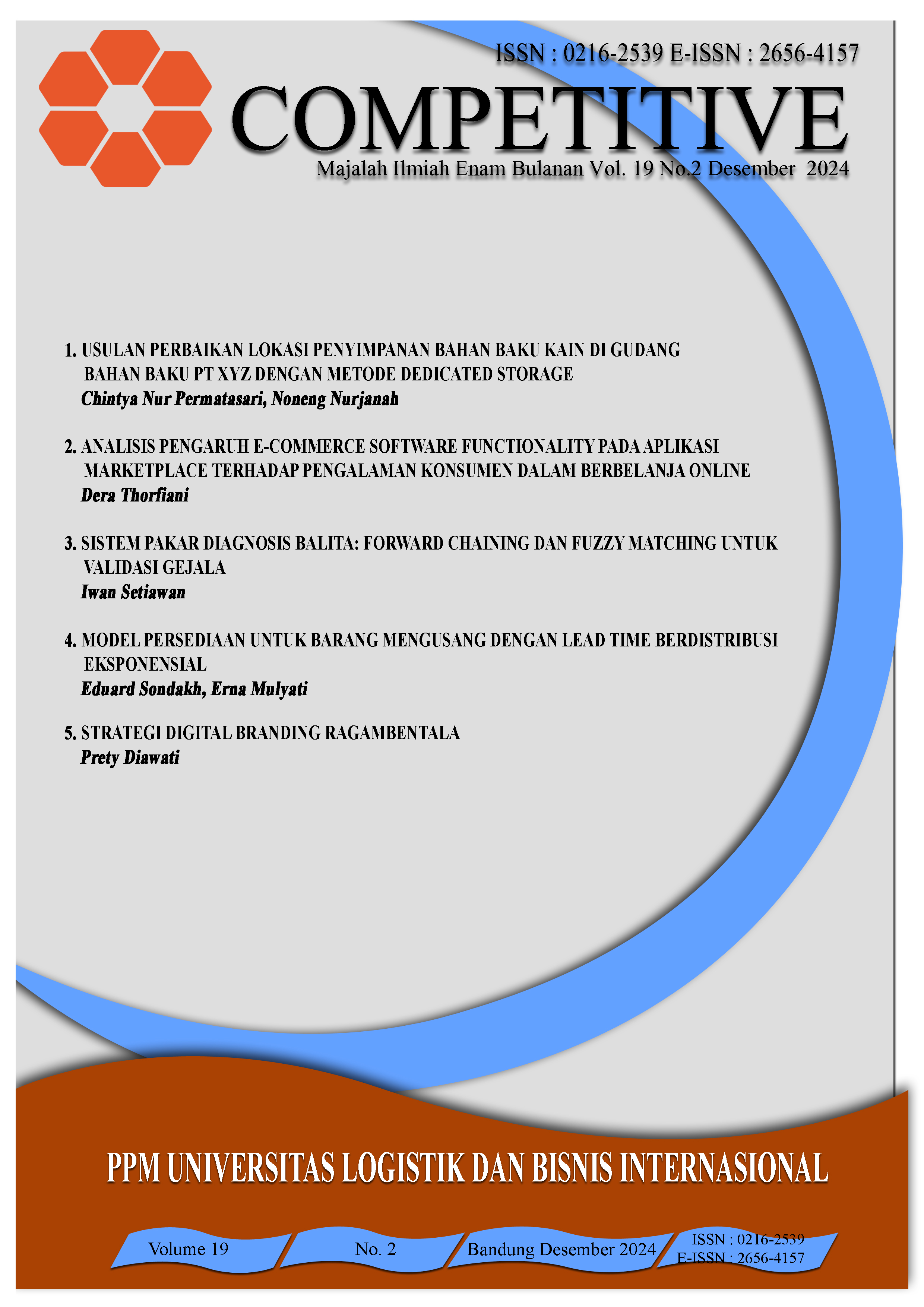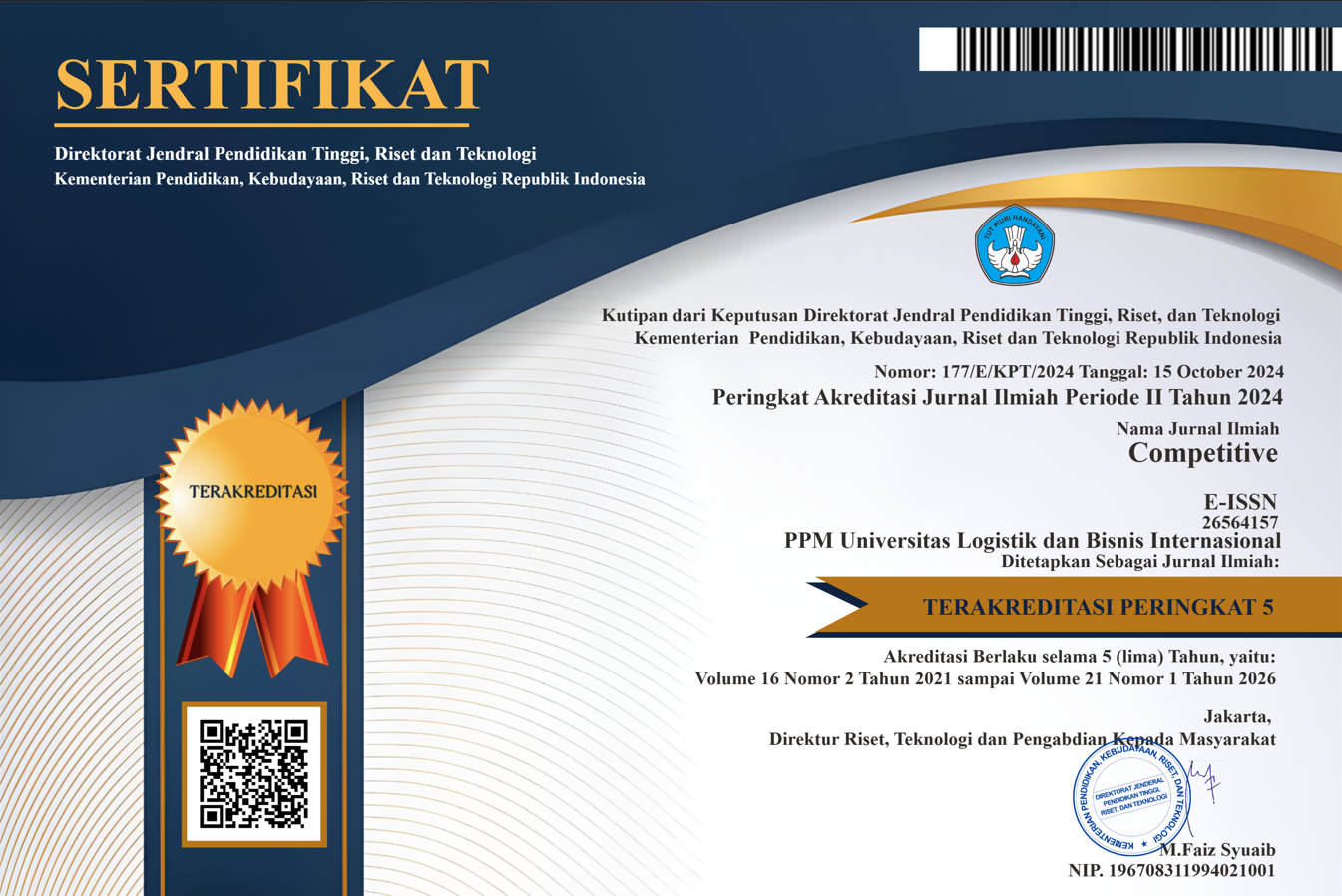ANALISIS PENGARUH E-COMMERCE SOFTWARE FUNCTIONALITY PADA APLIKASI MARKETPLACE TERHADAP PENGALAMAN KONSUMEN DALAM BERBELANJA ONLINE
DOI:
https://doi.org/10.36618/competitive.v19i2.4004Keywords:
aplikasi e-commerce, fitur platform e-commerce, pengalaman pelanggan, marketplaceAbstract
Munculnya e-commerce telah mengubah model penjulan produk secara retail, dimana aplikasi marketplace menjadi pemain kunci dalam membentuk pengalaman konsumen saat berbelanja. Platform e-commerce marketplace berusaha untuk meningkatkan pengalaman pengguna dengan meningkatkan interface dan konten pada platform untuk memudahkan konsumen saat bertransaksi. Penelitian ini bertujuan untuk menganalisis bagaimana peran fitur-fitur yang ada pada platform aplikasi marketplace yaitu e-commerce software functionality seperti katalog digital, keranjang belanja online, dan sistem pemmbayaran dapat mempengaruhi pengalamn konsumen saat berbelanja online. Berdasarkan hasil pengolahan data dengan metode SEM dengan menggunakan aplikasi SMART PLS, didapatkan hasil variabel Digital Catalog, Cart, dan Payment System pada E-commerce software functionality berpengaruh secara positif dan signifikan terhadap customer experience.
References
Al Rahamneh, A. A., Alrawashdeh, S. T., Bawaneh, A. A., Alatyat, Z., Mohammad, A., Mohammad, A. A. S., & Al-Hawary, S. I. S. (2023). The effect of digital supply chain on lean manufacturing: A structural equation modelling approach. Uncertain Supply Chain Management, 11(1), 391–402. https://doi.org/10.5267/j.uscm.2022.9.003
Amiri, S., & Woodside, J. M. (2017). Emerging markets: the impact of ICT on the economy and society. Digital Policy, Regulation and Governance , 19(5), 383–396. https://doi.org/10.1108/DPRG-04-2017-0013
Astuty, E. (2018). Soft Innovation Sebagai Strategi Peningkatan Kinerja Industri Kreatif Fesyen. In Universitas Pendidikan Indonesia, Bandung. Universitas Pendidikan Indonesia.
Bilgihan, A., Kandampully, J. A., & Zhang, T. (Christina). (2016). Towards a unified customer experience in online shopping environments: antecedents and outcomes. International Journal of Quality and Service Sciences Article, 8(1).
Fouskas, K., & Chatziharistou, C. (2020). E-commerce Success Factors: A Taxonomy and Application in the Fashion Industry. Springer Proceedings in Business and Economics, 775–782. https://doi.org/10.1007/978-3-030-36126-6_85
Fouskas, K., Pachni-Tsitiridou, O., & Chatziharistou, C. (2020). A Systematic Literature Review on E-commerce Success Factors. Springer Proceedings in Business and Economics, 687–694. https://doi.org/10.1007/978-3-030-36126-6_76
Hair Jr., J. F., Black, W. C., Babin, B. J., & Anderson, R. E. (2014). Multivariate Data Analysis (7th Editio). Pearson Education Limited.
Hair Jr., J. F., Hulth, T. M., Ringle, C. M., & Sarstedt, M. (2016). A Primer on Partial Least Squares Structural Equation Modeling (2nd editio). SAGE Publication,Inc. https://doi.org/10.1016/j.lrp.2013.01.002
Higueras-Castillo, E., Alves, H., Liébana-Cabanillas, F., & Villarejo-Ramos, Á. F. (2023). The consumer intention to use e-commerce applications in the post-pandemic era: a predictive approach study using a CHAID tree-based algorithm. European Journal of Management and Business Economics. https://doi.org/10.1108/EJMBE-12-2022-0375
Laudon, K. C., & Traver, C. G. (2016). E -commerce. business. technology. society. (12th Editi). Pearson Education Limited.
Melati, K. R., & Dewi S.P, N. K. (2020). Integrated E-commerce Ecosystem in China and Indonesia’s Giant Market. 423(Imc 2019), 251–269. https://doi.org/10.2991/assehr.k.200325.021
Nurul Marzuki, S., & Md Yasin, I. (2021). Factors Influencing Online Shoppers to Shop at Marketplace or Website: A Qualitative Approach. In Asian Journal of Business and Management (Vol. 9, Issue 4). www.ajouronline.com
Pires, P. B., Prisco, M., Delgado, C., & Santos, J. D. (2024). A Conceptual Approach to Understanding the Customer experience in E-commerce: An Empirical Study. Journal of Theoretical and Applied Electronic Commerce Research, 19(3), 1943–1983. https://doi.org/10.3390/jtaer19030096
Sekaran, U., & Bougie, R. (2016). Research Methods for Business (Seventh Ed). Wiley. https://doi.org/9781119165552
Shabrina, V. G. (2019). Pengaruh Revolusi Digital terhadap Pemasaran dan Perilaku Konsumen. Jurnal Pewarta Indonesia, 1(2). https://doi.org/10.25008/jpi.v1i2.16
Sihombing, J. C., Bangsawan, S., & Mahrinasari, M. S. (2023). The Effect of Shopping Orientation, Product Attributes, and Electronic Word of Mouth (E-WOM) on online Purchase Intent in The Marketplace. Journal Research of Social Science, Economics, and Management, 2(9), 2234–2251. https://doi.org/10.59141/jrssem.v2i10.447
Sugiyono. (2018). Metode Penelitian Bisnis Pendekatan Kuantitatif, Kualitatif, Kombinasi, dan R&D.
Sugiyono, Prof. D. (2017). Metode Penelitian Kombinasi (Mixed Methods) (M. T. Sutopo, Ed.). ALFABETA, cv.
Thorfiani, D., & Nurjanah, N. (2022). The New Retail Business Model and Customer experience: A Case Study on a Coffee Shop Retail. Icaess 2021, 227–235. https://doi.org/10.5220/0010860100003255
Thorfiani, D., Suarsa, S. H., & Oscar, B. (2021). Teknologi E-commerce dan Pengalaman Konsumen. Jkbm (Jurnal Konsep Bisnis Dan Manajemen), 7(2), 139–148. https://doi.org/10.31289/jkbm.v7i2.4623
Widjajanta, B., Lisnawati, L., Rahayu, A., Wibowo, L. A., & Hartono, C. M. (2022). Online Consumer Review in Building Willingness to Buy for Consumers of Food Products in Marketplaces during the Covid-19 Pandemic. www.sirclo.com
Yonatan, A. Z. (2024). Makin Maju, Pertumbuhan E-commerce Indonesia yang Diprediksi Tertinggi di Dunia. https://data.goodstats.id/statistic/makin-maju-pertumbuhan-e-commerce-indonesia-yang-diprediksi-tertinggi-di-dunia-QiN5h
Zakaria, J. (2024). PERAN E-COMMERCE DALAM PEMBANGUNAN EKONOMI DAERAH DI INDONESIA. Jurnal Ekonomi Pembangunan STIE Muhammadiyah Palopo, 10(1).
Downloads
Published
Issue
Section
License
Copyright (c) 2025 Competitive

This work is licensed under a Creative Commons Attribution-NonCommercial-ShareAlike 4.0 International License.









